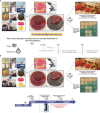Total Laboratory Automation for Rapid Detection and Identification of Microorganisms and Their Antimicrobial Resistance Profiles
- PMID: 35186794
- PMCID: PMC8851030
- DOI: 10.3389/fcimb.2022.807668
Total Laboratory Automation for Rapid Detection and Identification of Microorganisms and Their Antimicrobial Resistance Profiles
Abstract
At a time when diagnostic bacteriological testing procedures have become more complex and their associated costs are steadily increasing, the expected benefits of Total laboratory automation (TLA) cannot just be a simple transposition of the traditional manual procedures used to process clinical specimens. In contrast, automation should drive a fundamental change in the laboratory workflow and prompt users to reconsider all the approaches currently used in the diagnostic work-up including the accurate identification of pathogens and the antimicrobial susceptibility testing methods. This review describes the impact of TLA in the laboratory efficiency improvement, as well as a new fully automated solution for AST by disk diffusion testing, and summarizes the evidence that implementing these methods can impact clinical outcomes.
Keywords: Colibri; Copan; Radian; WASPLab artificial intelligence; WASPLab® platform; antimicrobial susceptibility testing; total laboratory automation.
Copyright © 2022 Cherkaoui and Schrenzel.
Conflict of interest statement
The authors declare that the research was conducted in the absence of any commercial or financial relationships that could be construed as a potential conflict of interest.
Figures





References
-
- Akerlund A., Jonasson E., Matuschek E., Serrander L., Sundqvist M., Kahlmeter G., et al. . (2020). EUCAST Rapid Antimicrobial Susceptibility Testing (RAST) in Blood Cultures: Validation in 55 European Laboratories. J. Antimicrob. Chemother. 75, 3230–3238. doi: 10.1093/jac/dkaa333 - DOI - PMC - PubMed
-
- Angeletti S., Dicuonzo G., D’Agostino A., Avola A., Crea F., Palazzo C., et al. . (2015). Turnaround Time of Positive Blood Cultures After the Introduction of Matrix-Assisted Laser Desorption-Ionization Time-of-Flight Mass Spectrometry. New Microbiol. 38, 379–386. - PubMed
-
- Barberis C., Almuzara M., Join-Lambert O., Ramirez M. S., Famiglietti A., Vay C. (2014). Comparison of the Bruker MALDI-TOF Mass Spectrometry System and Conventional Phenotypic Methods for Identification of Gram-Positive Rods. PloS One 9, e106303. doi: 10.1371/journal.pone.0106303 - DOI - PMC - PubMed
Publication types
MeSH terms
Substances
LinkOut - more resources
Full Text Sources
Medical

